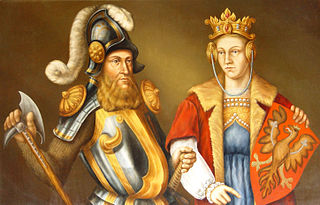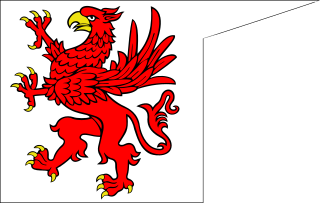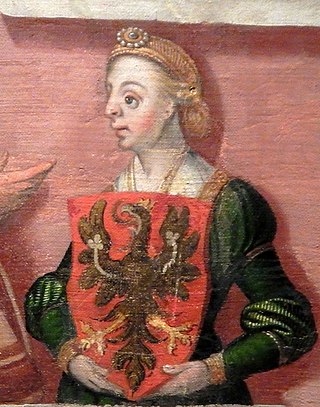The House of Griffin or Griffin dynasty was a dynasty ruling the Duchy of Pomerania from the 12th century until 1637. The name "Griffins" was used by the dynasty after the 15th century and had been taken from the ducal coat of arms. Duke Wartislaw I was the first historical ruler of the Duchy of Pomerania and the founder of the Griffin dynasty. The most prominent Griffin was Eric of Pomerania, who became king of the Kalmar Union in 1397, thus ruling Denmark, Sweden and Norway. The last Griffin duke of Pomerania was Bogislaw XIV, who died during the Thirty Years' War, which led to the division of Pomerania between Brandenburg-Prussia and Sweden. Duchess Anna von Croy, daughter of Duke Bogislaw XIII and the last Griffin, died in 1660.

Bogislaw V, sometimes known as the Great, was a Duke of Pomerania.

Pomerania during the Late Middle Ages covers the history of Pomerania in the 14th and 15th centuries.

The Duchy of Pomerania-Wolgast, also known as the Duchy of Wolgast, and the Duchy of Wołogoszcz, was a feudal duchy in Western Pomerania within the Holy Roman Empire. Its capital was Wolgast. It was ruled by the Griffin dynasty. It existed in the Late Middle Ages era from 1295 to 1478.

The Duchy of Pomerania-Stettin, also known as the Duchy of Stettin, and the Duchy of Szczecin, was a feudal duchy in Farther Pomerania within the Holy Roman Empire. Its capital was Szczecin. It was ruled by the Griffin dynasty. It existed in the eras of the High and Late Middle Ages, and the early modern period, between 1160 and 1264, between 1295 and 1523, and between 1532 and 1625.

The Duchy of Pomerania-Stolp, also known as the Duchy of Stolp, and the Duchy of Słupsk, was a feudal duchy in Farther Pomerania. Its capital was Słupsk. It was ruled by the Griffin dynasty. It existed in the High Middle Ages era from 1368 to 1478.

Bogisław VIII, a member of the House of Griffins, was Duke of Pomerania ruling in Pomerania-Stolp from 1395 until his death. He also served as administrator of the Prince-Bishopric of Cammin from 1387 and as Cammin Prince-bishop from 1394 to 1398.
Swantibor I, previously referred to by historians as Swantibor III was a member of the House of Griffins, a Duke of Pomerania-Stettin and for a while governor of the Mittelmark.

Maria of Masovia was a Duchess of Pomerania by marriage to Bogislaw IX, Duke of Pomerania, and regent of Pomerania from 1446 to 1449.
The Duchy of Pomerania-Neustettin, also known as the Duchy of Neustettin, and the Duchy of Szczecinek, was a feudal duchy of the Holy Roman Empire located in Middle Pomerania. It existed between 1372 and 1478. Its capital was Szczecinek. It was formed from the part of the territories Pomerania-Wolgast on 8 June 1368 and existed until 1390 when it was incorporated back into Pomerania-Wolgast. Its only ruler was Duke Wartislaw V of the House of Griffins.
The Duchy of Pomerania-Schlawe, also known as the Duchy of Sławno, was a feudal duchy with its capital in Sławno, located in Pomerania within the Holy Roman Empire. It was formed in 1190, when it separated from Pomerania-Stettin. In 1238 it was conquered and incorporated into the Duchy of Gdańsk.
Duchy of Białogarda was a duchy in the Pomerelia centred around its capital, Białogarda. It was formed in 1233 from the partition of the Duchy of Świecie and Lubiszewo, and existed until 1262 when it was incorporated into the State of the Teutonic Order. Its only ruler was duke Racibor of Białogarda of the Samboride dynasty.

Ratibor of Białogarda was a duke from the Samboride dynasty. From 1233 until 1262, he was a duke of the Duchy of Białogarda. In 1262, he became the knight of the Teutonic Order, giving his lands to it.
Uckermark War was a military conflict fought in Uckermark and Mittelmark in Brandenburg, between October 1412 and 16 December 1415. It was fought by Pomerania-Stettin against the Margraviate of Brandenburg and Pomerania-Wolgast. The war was won by Brandenburg, with them annexing Uckermark.

Battle of Kremmer Levee was a battle of Uckermark War, fought on 24 October 1412, on the Kremmer Levee, near the village of Kremmen. It was fought by forces of Pomerania-Stettin against the Margraviate of Brandenburg.
The Duchy of Pomerania-Demmin, also known as the Duchy of Demmin, and the Duchy of Dymin, was a feudal duchy in Western Pomerania within the Holy Roman Empire. Its capital was Demmin. It was ruled by the Griffin dynasty. It existed in the High Middle Ages era, between 1160 and 1264.

The Duchy of Wolgast-Stolp, also known as the Duchy of Wolgast and Stolp, and the Duchy of Wołogoszcz and Słupsk, was a feudal duchy in Western Pomerania within the Holy Roman Empire. Its capital was Wolgast. It was ruled by the Griffin dynasty. It existed in the eras of Late Middle Ages and the Early modern period, from 1532 to 1625.
The Duchy of Pomerania-Rügenwalde, also known as the Duchy of Rügenwalde, and the Duchy of Darłowo, was a feudal duchy in Western Pomerania within the Holy Roman Empire. Its capital was Darłowo. It was ruled by the Griffin dynasty. It existed in the early modern period, from 1569 to 1625.

Joachim, also known as Joachim I, Joachim the Younger, and Joachim of Pomerania, was a member of the House of Griffin, and the duke of Pomerania-Stettin, that ruled from 1434 to 1451.











